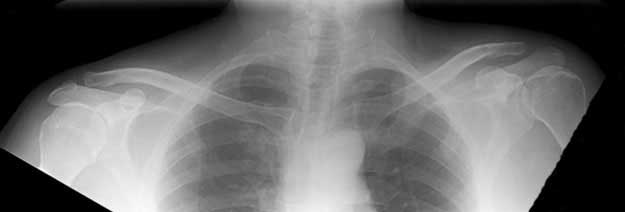AC Joint Dislocation

Acromioclavicular (AC) joint injury is also known as lifting up of lateral end of Collar Bone. It is a common injury to the acromioclavicular joint which causes injury to the acromioclavicular ligaments and/or coracoclavicular (CC) ligaments.
The injury causes intense pain and discomfort and immediate medical help should be sought for the injury. The treatment commonly involves immobilization of the joint or surgical reconstruction depending on the extent of injury.
Cause of AC Joint Dislocation
The injury is most commonly found in people playing active sports. It is caused due a fall on the shoulder tip or on an outstretched hand leading to damage.
Symptoms of AC Joint Dislocation
The common symptoms of AC Joint Dislocation consist of:
- Tremendous pain with other injuries
- Complete shoulder movement lock
- Swelling and bruising around the shoulder
- Visible shoulder droop


AC Joint Dislocation Diagnosis
A detailed physical examination includes comparing the shoulder position to another one. The Physical examination is followed by:
- X-Rays
- MRI – to find out significant tissue stretch and tear
The separation is classified into 6 types, with 1 through 3 increasing in severity, and 4 through 6 being the most severe.
Type 1 – It is essentially a sprain without causing any major tear to the AC or CC ligaments and damage to the joint.
Type 2 – It is the complete tearing of the AC tissue and partial tear or sprain of the CC tissue. This causes intense pain and loss of movement.
Type 3 – It is the tearing of both AC and CC tissues much interference of the deltoid or trapezial fascia. A permanent significant bump is formed. This causes intense pain while shoulder movement.
Type 4 – It is the tearing of both AC and CC tissues with a displaced clavicle. This injury usually leads to surgery.
Type 5 – It is the severe tearing of both AC and CC tissues with the trapezial and deltoid fascia exposed off of the acromion and the clavicle. This injury usually requires surgery.
Type 6 – It is the severe tearing of both AC and CC tissues with multiple other injuries. It causes dislocation of the distal end of the clavicle underneath the coracoids. This is a rare type as compared to others. This requires surgery.
AC Joint Dislocation treatment

Prompt medical attention is needed after the dislocation. The shoulder should not be moved at all to avoid discomfort and further complications until the medical attention is sought.
Type 1 and type 2 injuries are most common and rarely need surgery.
Type 3 may or may not require a surgery and depend upon the diagnosis and the surgeon’s decision.
Type 4, Type 5 and Type 6 injuries are rare but can be treated by surgery only.
A small cut is made to the shoulder and implants are placed such that it reduces AC joint dislocation, closure is done using a stapler or sutures .
The recovery period may differ on the basis of age of the patient and the extent of the injury.
AC Joint Dislocation Recovery
The full recovery takes weeks and depends totally upon damages and physiotherapy.
A sling or belt is tied to immobilize the shoulder to let the injury heal. Extreme care is necessary to not cause a following injury to the shoulder. Proper medication and regular follow-ups should not be avoided.
Guided physiotherapy is a must. It consists of various weight and stretching exercises. It helps in regaining the full range motion by strengthening the shoulder muscles.
Dr. Parth Agrawal is an orthopedic surgeon who specializes in upper limb treatments. He is available at The Upper Limb Clinic, Thane.
The Upper Limb Clinic, Thane west, is dedicated clinic for all diseases related to Knee, Hand, Shoulder, Elbow and Wrist. Contact us today for AC Joint Dislocation Surgery to get better and accurate treatment.

